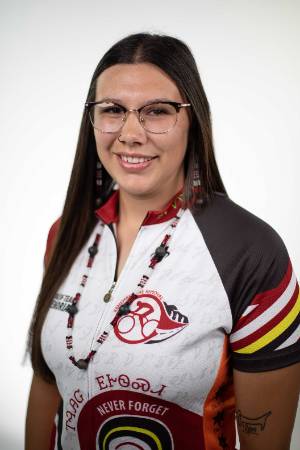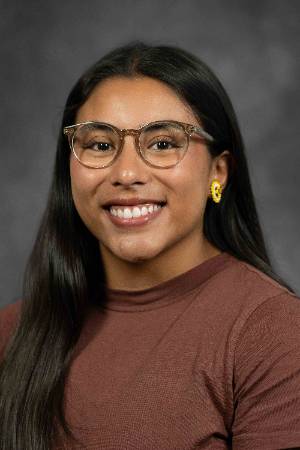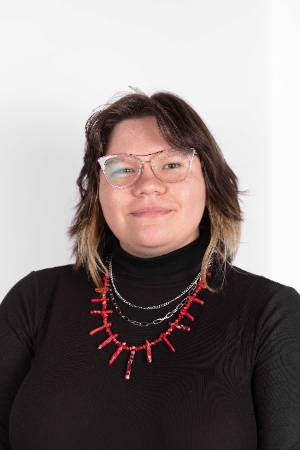NSU celebrates Native student achievements
TAHLEQUAH, Okla. — Three students from Northeastern State University are being recognized for their accomplishments after participating in various summer programs.
Amaiya Bearpaw, Bethany Mejia and Makiya Deerinwater demonstrated their commitment to academic excellence, cultural preservation and community service while embodying the spirit of Indigenous leadership and heritage preservation.
Bearpaw, a Cherokee Nation citizen and representative of the Choctaw Nation, participated in Remember the Removal, an annual bike ride totaling 950 miles from New Echota, Georgia to Tahlequah, Oklahoma. The Cherokee Nation created this program in 1984 where a youth group ranging from ages 16 to 24 are accompanied by mentor riders and the Eastern Band of Cherokee Indians to retrace the Trail of Tears.
The process begins with an application, selection, interview and six months of physical training. Riders make several stops along the way, each holding a significance in the history of the Trail of Tears.
“We stopped at multiple locations along the ride, but my favorite and the most touching for me as a rider and Cherokee Nation citizen was Blythe’s Ferry,” Bearpaw said. “This was the place where our ancestors last got to see the homelands before they crossed the Tennessee River. This experience helped me gain a better knowledge of where my ancestors came from and why they were removed. I would do it over again in a heartbeat.”
Bearpaw graduates this fall with a degree in geography and sustainability studies and will be working through a fellowship with the Trail of Tears National Historic Trail as part of the National Park Service with hopes to continue learning and preserving her heritage.
Mejia, an Arkansas native and citizen of the Cherokee Nation, spent her summer participating in the Native American Research Internship (NARI) at the University of Utah. NARI is a 10-week summer program that fully immerses indigenous students into the world of biomedical research.
“My specific project worked with a current Parkinson’s treatment that has been shown to be toxic towards patients,” Mejia said. “There were 28 students in the cohort that were placed in various research labs tasked with different projects.”
She said students conducted research Monday – Friday from 9 – 5 p.m. When they weren’t in the lab, they were given multiple cultural opportunities such as attending powwows, hoop dancing and beadwork workshops as well as medical workshops like sutures, vitals and clinical shadowing opportunities.
“My favorite part of the program was how NARI was able to tie all of our research and professional development opportunities back to the Indigenous life,” Mejia said. “This experience has given me a new outlook on life as an Indigenous student. I want to encourage other Indigenous students to go all in and follow their dreams by attending great programs like this one.”
Mejia is a junior at NSU studying cell and molecular biology. After college, she plans to apply to a post-bachelor’s degree program where she can further her research experience while studying for the Medical College Admission Test (MCAT). From there she hopes to apply to MD/PhD programs across the country.
“Participating in NARI has drastically improved my professional skills and has given me a new insight on life beyond Oklahoma and Arkansas,” Mejia said.
Deerinwater grew up in Tahlequah where her love and passion for artwork and design began in kindergarten although she did not feel confident in her work until she began classes at NSU.
“I found myself becoming more passionate about art when I began working on my degree classes at NSU,” Deerinwater said. “Until then, I had only done sketches but nothing serious. After taking some of the core art classes for my degree, I knew this is what I wanted to do for myself and my career.”
As a citizen of the Cherokee Nation, Deerinwater participates in Native art shows showcasing her artistic abilities and deep cultural connections. This year, she has participated in several art shows like the Cherokee Nation Trail of Tears Art Show where her piece, “M.M.I.W,” was awarded 2nd place in the Graphics Division.
“Another show I partook in was the Cherokee Nation Homecoming Art Show that took place Aug. 12 to Sept. 9,” Deerinwater said. “My piece ‘Foot’ was awarded the Bill Rabbit Legacy Award.”
Her participation in these events highlights the importance of preserving indigenous art and storytelling, conveying the rich history and experiences of the Cherokee people.
Deerinwater is a junior at NSU studying fine arts with a graphic design emphasis. After graduating, she plans to work full-time with the Language Department at the Cherokee Nation to create graphics and illustrations.
“I currently work part-time in this department and have created illustrations for a few of their short story books,” Deerinwater said. “Overall, I want to learn my Cherokee language more and improve my art skills by trying out different mediums and getting out of my comfort zone.”
“I am incredibly proud of these ladies – they have each challenged themselves in different ways to reach their educational, career and personal goals,” Sara Barnett, director for the Center for Tribal Studies said. “These are just a few examples of the success stories we see in our students every semester. We [NSU] are so lucky to have so many talented Native scholars who are invested in their culture and communities.”
CTS has been one of the central resources on campus since its inception in 1990. The center focuses on supporting academic effectiveness, enhancing the quality of student experiences, initiating scholarly activities, bridging communication between tribal nations and the university and enriching the cultural heritage of the NSU community.
To learn more about CTS and the opportunities they offer, visit cts.nsuok.edu or see them in person at their new location in the basement of the University Center on the Tahlequah campus.
Amaiya Bearpaw

Bethany Mejia

Makiya Deerinwater

